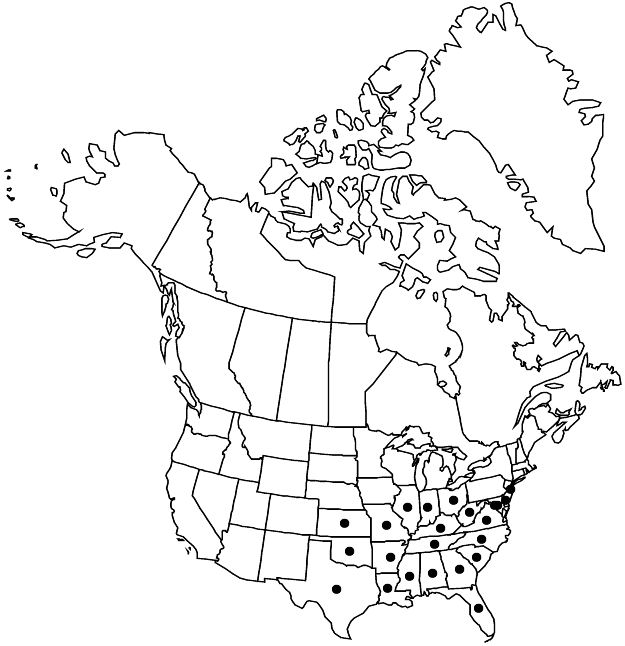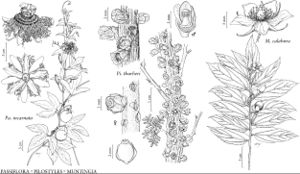Passiflora incarnata
Sp. Pl. 2: 959. 1753.
Stems terete, short-hairy, (bark not corky, above-ground stems annual). Leaves weakly to moderately pungent, sparsely to moderately hairy; stipules linear-setaceous, 3–5 × 0.5 mm, eglandular; petiole glandular, glands emergent protuberances; blade roughly symmetric, 4–12(–22) × 4–12(–30) cm, deeply 3(–5)-lobed, middle lobe as long as or longer than lateral lobes, margins serrate; abaxial fine veins prominently raised, abaxial nectaries absent.
Phenology: Flowering (Mar–)Apr–Oct(–Nov).
Habitat: Open woodlands, savannas, prairies, dunes, cultivated ground and disturbed areas, in clayey, loamy, or sandy, dry to mesic, and often poor soil
Elevation: 0–400(–1000) m
Distribution

Ala., Ark., Del., D.C., Fla., Ga., Ill., Ind., Kans., Ky., La., Md., Miss., Mo., N.J., N.C., Ohio, Okla., S.C., Tenn., Tex., Va., W.Va.
Discussion
Passiflora incarnata probably has been expanding its range due to its preference for open, disturbed areas, possibly since prior to European settlement (K. J. Gremillion 1989). The species is probably native no farther north than southern Illinois and Ohio, central or southern Virginia, and central West Virginia (C. Frye and B. McAvoy, pers. comm.); it is very cold-hardy, and is introduced sporadically northwards (for example, G. Moore 1989; G. J. Wilder and M. R. McCombs 2002). This species can spread over large areas in well-drained soil, primarily by suckers from deep, far-spreading roots, and has been considered a weed of croplands (W. C. Muenscher 1980). Despite its aggressiveness, it is considered rare in some parts of its range (Indiana, Ohio).
Passiflora incarnata is used for its sedative properties (J. A. Beutler and A. DerMarderosian 2005; A. Chevallier 1996). The species was possibly cultivated by Native Americans, or at least exploited by them for its edible fruit, for over 3,000 years prior to European settlement in North America (K. J. Gremillion 1989). The Cherokee used it for skin infections and earaches, as a liver tonic, and for weaning babies, and the Houma used it as a blood tonic (D. E. Moerman 1986). Fruits of P. incarnata vary in palatability, more flavorful ones suggesting potential value as a fruit crop (C. M. McGuire 1999).
A similar species, Passiflora edulis Sims, has been sparingly naturalized in southern Florida (R. P. Wunderlin and B. F. Hansen 2003), although such material has not been collected there since the 1960s. It is closely related to P. incarnata (V. C. Muschner et al. 2003) and will key to this species in this treatment. Passiflora edulis differs from P. incarnata by its larger stipules, at least 10 mm; leaf margins generally more coarsely serrate; larger, leaflike floral bracts, at least 17 × 8 mm; and a broadly and abruptly expanded androgynophore base (gradually expanded in P. incarnata). Passiflora ‘Incense’, an artificial hybrid between P. incarnata and the South American P. cincinnata Masters, also will key to P. incarnata in this treatment. It differs from the latter by consistently having five-lobed leaves with lobes that are much-narrowed basally, and larger floral bracts, at least 15 × 10 mm.
Selected References
None.
